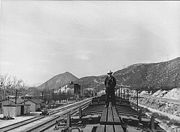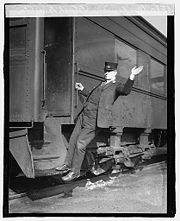
Brakeman
Encyclopedia

Rail transport
Rail transport is a means of conveyance of passengers and goods by way of wheeled vehicles running on rail tracks. In contrast to road transport, where vehicles merely run on a prepared surface, rail vehicles are also directionally guided by the tracks they run on...
worker whose original job it was to assist the braking of a train by applying brakes on individual wagons. The advent of through brakes on trains made this role redundant, although the name lives on in the United States where brakemen carry out a variety of functions both on the track and within trains.
USA
In the US, the brakeman was a member of a railroad train's crew responsible for assisting with braking a train when the conductorConductor (transportation)
A conductor is a member of a railway train's crew that is responsible for operational and safety duties that do not involve the actual operation of the train. The title of conductor is most associated with railway operations in North America, but the role of conductor is common to railways...
wanted the train to slow down. A brakeman's duties also included ensuring that the coupling
Coupling (railway)
A coupling is a mechanism for connecting rolling stock in a train. The design of the coupler is standard, and is almost as important as the railway gauge, since flexibility and convenience are maximised if all rolling stock can be coupled together.The equipment that connects the couplings to the...
s between cars were properly set, lining switches
Railroad switch
A railroad switch, turnout or [set of] points is a mechanical installation enabling railway trains to be guided from one track to another at a railway junction....
, and signaling to the train operators while performing switching operations. The brakemen rode in the caboose
Caboose
A caboose is a manned North American rail transport vehicle coupled at the end of a freight train. Although cabooses were once used on nearly every freight train, their use has declined and they are seldom seen on trains, except on locals and smaller railroads.-Function:The caboose provided the...
, the last car in the train, which was built specially to allow a crew member to apply the brakes of the caboose quickly and easily, which would help to slow the train. In rare cases, such as descending a long, steep grade, brakemen might be assigned to several cars, and be required to operate the brakes while the train was moving from atop the train. Brakemen were also required to watch the train when it was underway to look for signs of hot box
Hot box
A hot box is the term used when an axle bearing overheats on a piece of railway rolling stock. The term is derived from the journal-bearing trucks used before the mid 20th century. The axle bearings were housed in a box that used oil-soaked rags or cotton to reduce the friction of the axle...
, (a dangerous overheating of axles,) as well as for people trying to ride the train for free, and cargo shifting or falling off.
As rail transport technology has improved, a brakeman's duties have been reduced and altered to match the updated technology, and the brakeman's job has become much safer than it was in the early days of railroading. Individually operated car brakes were replaced with automatic air brake
Air brake (rail)
An air brake is a conveyance braking system actuated by compressed air. Modern trains rely upon a fail-safe air brake system that is based upon a design patented by George Westinghouse on March 5, 1872. The Westinghouse Air Brake Company was subsequently organized to manufacture and sell...
s, eliminating the need for the brakeman to walk atop a moving train to set the brakes. Link and pin couplings were replaced with automatic couplings, and hand signals are now supplemented by two-way radio communication.
Germany
In Germany, the brakemen occupied brakeman's cabinBrakeman's cabin
A brakeman's cabin or brakeman's caboose was a small one-man compartment at one end of a railway wagon to provide shelter for the brakeman from the weather and in which equipment for manually operating the wagon brake was located...
s on several or even all wagons in a train and would operate the wagon brakes when signaled by the engine driver. It was a dangerous and uncomfortable role, especially in winter when it was not uncommon for brakemen to freeze to death in the unheated cabins.
The function was abolished in the 1920s with the introduction of air brakes, which could be controlled by the engine driver
Driver
-Surnames of people:* Alexander Gooch and Alice Driver , English Protestant martyrs* Andrew Driver , English professional footballer* Betty Driver , English singer, actress and author...
.
Duties today

In passenger service, the brakeman (called trainman or assistant conductor) collects revenue, may operate door "through switches" for specific platforming needs, makes announcements, and operates trainline door open and close controls when required to assist the conductor. A passenger service trainman is often required to qualify as a conductor after 1 to 2 years experience. The rear end trainman signals to the conductor when all the train's doors are safely closed, then boards and closes his/her door.
Scenic Railways
Scenic Railways particularly in the form of side friction roller coasters require a brakeman to ride with the train around the track to slow it down at certain points on the layout, particularly bends; as the trains are not mechanically held onto the track. The brakeman is responsible for slowing the train down when necessary and stopping it in the station at the end of the ride. There are only a few examples of such rides now left in existence; the Scenic Railway at Luna Park, MelbourneLuna Park, Melbourne
For other amusement parks of the same name, see Luna Park; for other uses of the phrase, see Luna Park Melbourne's Luna Park is a historic amusement park located on the foreshore of Port Phillip Bay in St Kilda, Victoria, an inner suburb of Melbourne, Australia...
Australia
Australia
Australia , officially the Commonwealth of Australia, is a country in the Southern Hemisphere comprising the mainland of the Australian continent, the island of Tasmania, and numerous smaller islands in the Indian and Pacific Oceans. It is the world's sixth-largest country by total area...
and the Roller Coaster
Scenic Railway Roller Coaster
The Scenic Railway Roller Coaster, known simply as the Scenic or Roller Coaster, is a wooden triple out-and-back scenic railway at Great Yarmouth Pleasure Beach, Great Yarmouth, UK. The ride was built at the park in 1932 and has been operational ever since. It stands and operates as the only...
at Great Yarmouth Pleasure Beach
Great Yarmouth Pleasure Beach
Great Yarmouth Pleasure Beach is a historic free entry pleasure park located in the seaside resort town of Great Yarmouth, Norfolk, on the English east coast. The park first opened in 1909 and has been operating ever since....
, UK are two of the largest examples.
See also
- Brakeman's cabinBrakeman's cabinA brakeman's cabin or brakeman's caboose was a small one-man compartment at one end of a railway wagon to provide shelter for the brakeman from the weather and in which equipment for manually operating the wagon brake was located...
- Jimmie RodgersJimmie Rodgers (country singer)James Charles Rodgers , known as Jimmie Rodgers, was an American country singer in the early 20th century known most widely for his rhythmic yodeling...
, "the Singing Brakeman" - Passenger guard – UK equivalent for passenger operations

